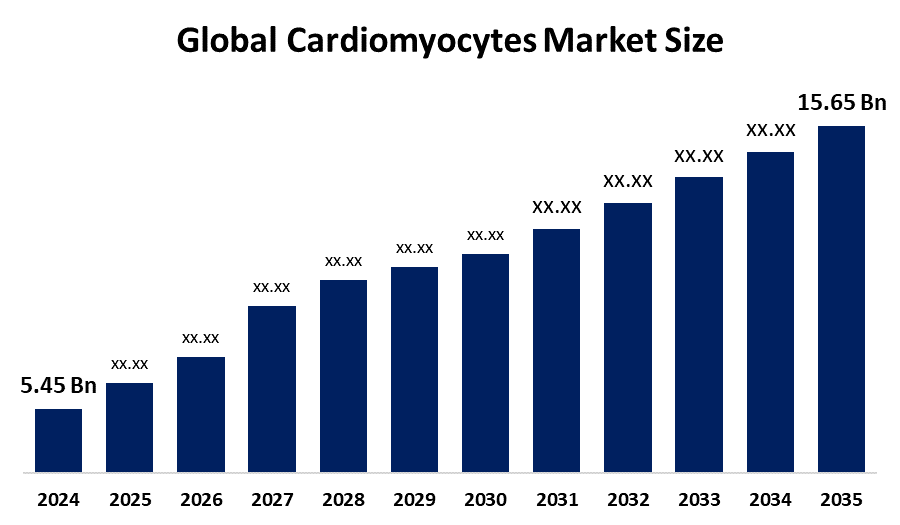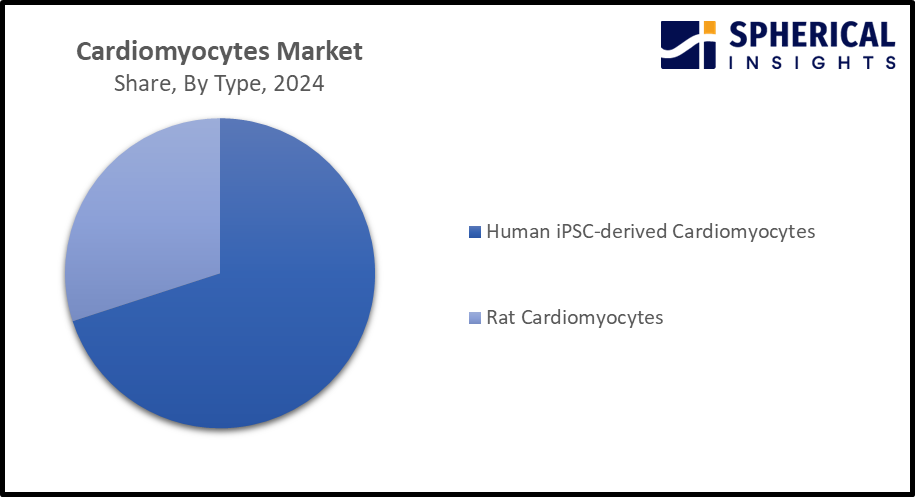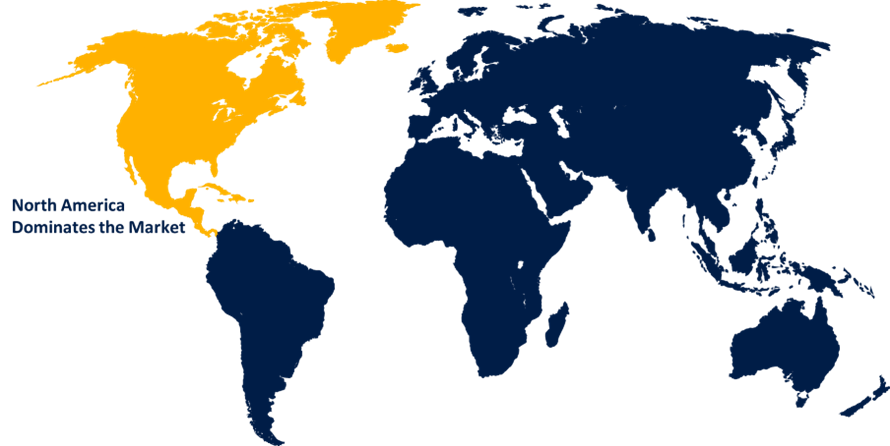Global Cardiomyocytes Market Size, Share, and COVID-19 Impact Analysis, By Type (Human iPSC-derived Cardiomyocytes and Rat Cardiomyocytes), By Application (Independent Assays, Cardiac Disease Modeling, and Cardiac Safety & Toxicity), and By Region (North America, Europe, Asia-Pacific, Latin America, Middle East, and Africa), Analysis and Forecast 2025 - 2035
Industry: HealthcareGlobal Cardiomyocytes Market Size Insights Forecasts to 2035
- The Global Cardiomyocytes Market Size Was Estimated at USD 5.45 Billion in 2024
- The Market Size is Expected to Grow at a CAGR of around 10.06% from 2025 to 2035
- The Worldwide Cardiomyocytes Market Size is Expected to Reach USD 15.65 Billion by 2035
- Asia Pacific is expected to grow the fastest during the forecast period.

Get more details on this report -
According to a Research Report Published by Spherical Insights and Consulting, The Global Cardiomyocytes Market Size was worth around USD 5.45 Billion in 2024 and is predicted to Grow to around USD 15.65 Billion by 2035 with a compound annual growth rate (CAGR) of 10.06% from 2025 and 2035. The market for cardiomyocytes presents numerous opportunities for growth, driven by advancements in stem cell technology and the increasing prevalence of cardiovascular diseases.
Market Overview
The global cardiomyocytes market is focused on the research, development, and supply of cardiomyocytes (heart muscle cells) for applications such as drug testing, disease modelling, and potential cell-based therapies. Cardiomyocytes refer to the cells of cardiac muscle responsible for generating contractile force in the intact heart. Hypertrophy of cardiomyocytes in response to chronic need for increased contractile force may lead to heart failure due to insufficient cardiac output. The signalling pathways associated with cardiomyocyte death are targeted with drugs and therapies to promote cardiomyocyte survival.
Innovation and market expansion are anticipated as a result of major players' growing R&D expenditures and the expanding partnerships. Recently, human-induced pluripotent stem cell-derived cardiomyocyte (hiPSC-CM)-based cell therapy has been used to potentially treat injured hearts, along with the use of multiple strategies such as cell cycle regulators, small molecules, co-culture systems, and epigenetic modifiers for improving hiPSC-CM proliferation in the field of cardiovascular regenerative medicine, which is driving a huge surge in the global cardiomyocytes market.
Report Coverage
This research report categorizes the cardiomyocytes market based on various segments and regions, forecasts revenue growth, and analyzes trends in each submarket. The report analyses the key growth drivers, opportunities, and challenges influencing the cardiomyocytes market. Recent market developments and competitive strategies such as expansion, type launch, development, partnership, merger, and acquisition have been included to draw the competitive landscape in the market. The report strategically identifies and profiles the key market players and analyses their core competencies in each sub-segment of the cardiomyocytes market.
Global Cardiomyocytes Market Report Coverage
| Report Coverage | Details |
|---|---|
| Base Year: | 2024 |
| Market Size in 2024: | USD 5.45 Billion |
| Forecast Period: | 2025-2035 |
| Forecast Period CAGR 2025-2035 : | 10.06% |
| 2035 Value Projection: | USD 15.65 Billion |
| Historical Data for: | 2020-2023 |
| No. of Pages: | 243 |
| Tables, Charts & Figures: | 120 |
| Segments covered: | By Type, By Application and COVID-19 Impact Analysis |
| Companies covered:: | AstraZeneca, Novartis, Pfizer, Roche, Johnson & Johnson, Merck & Co., Inc., Bayer, Abbott Laboratories, Bristol Myers, Cytiva, Axol Bioscience Ltd., Cell Applications, Inc., R&D Systems, Inc., Cellular Dynamics International, and Others |
| Pitfalls & Challenges: | COVID-19 Impact, Challenges, Future, Growth, & Analysis |
Get more details on this report -
Driving Factors
The rapidly ageing population, especially in Western societies, is responsible for driving the cardiomyocytes market, as age and cardiovascular diseases are positively correlated. Heart failure is the primary disorder in the elderly in the developed world, growing from 1% among those aged 45-55 years to over 10% in those over 80 years old. The growing advancement in manufacturing cardiomyocytes with the emergence of human pluripotent stem cell (hPSC) technology is contributing to propel the market growth.
Restraining Factors
The cardiomyocytes market is restricted by the limited availability of treatment options and the increased cost of treatment, which includes heart transplants and new experimental therapies, making it inaccessible for patients. Further, the regulatory complexities associated with safety & quality, as well as the lack of infrastructure & equipment, are impeding the cardiomyocytes market.
Market Segmentation
The cardiomyocytes market share is classified into type and application.
- The human iPSC-derived cardiomyocytes segment dominated the market with the largest share of about 69.5% in 2024 and is projected to grow at a substantial CAGR during the forecast period.
Based on the type, the cardiomyocytes market is divided into human iPSC-derived cardiomyocytes and rat cardiomyocytes. Among these, the human iPSC-derived cardiomyocytes segment dominated the market with the largest share of about 69.5% in 2024 and is projected to grow at a substantial CAGR during the forecast period. Human iPSC-CMs are invaluable for cardiac disease modelling and regeneration, and are useful for enhancing the accuracy, precision, and efficiency of cardiotoxicity hazard identification. It is widely used cell-based models resulting from the discovery of non-embryonic stem cells that can be differentiated into multiple cell types. The growing prevalence of cardiac disorders, including coronary heart disease, stroke, hypertension, and congestive heart failure, is propelling the market demand.

Get more details on this report -
- The cardiac safety & toxicity segment dominated the cardiomyocytes market with about 30-60% share in 2024 and is anticipated to grow at a significant CAGR during the forecast period.
Based on the application, the cardiomyocytes market is divided into independent assays, cardiac disease modeling, and cardiac safety & toxicity. Among these, the cardiac safety & toxicity segment dominated the cardiomyocytes market with about 30-60% share in 2024 and is anticipated to grow at a significant CAGR during the forecast period. Cardiac safety and toxicity assessment is essential for reducing the increased rate of drug withdrawals during development. hiPSC-CMs have emerged as a promising platform owing to their expression of cardiac-specific ion channels and electrophysiological properties. The prevalence of cancer therapy cardiotoxicity is contributing to propel the market demand in the cardiac safety & toxicity segment.
Regional Segment Analysis of the Cardiomyocytes Market
- North America (U.S., Canada, Mexico)
- Europe (Germany, France, U.K., Italy, Spain, Rest of Europe)
- Asia-Pacific (China, Japan, India, Rest of APAC)
- South America (Brazil and the Rest of South America)
- The Middle East and Africa (UAE, South Africa, Rest of MEA)
North America is anticipated to hold the largest share of the cardiomyocytes market over the predicted timeframe.

Get more details on this report -
North America is anticipated to hold the largest share of about 35% in the cardiomyocytes market over the predicted timeframe. The market ecosystem in North America is strong, due to advanced microneedle innovations in cardiovascular and metabolic disease management. The growing experimental study on pathologic cardiac hypertrophy in heart failure, and safety research on cardiomyocytes are anticipated to support market growth. For instance, in July 2025, the American Journal of Pathology published an article studying the role of endothelial cell stimulator of Interferon genes in experimental heart failure. The United States is leading the cardiomyocytes market in the North America with an estimated 24% to 28% share, owing to the growing prevalence of cardiovascular diseases and age-related death rates related to cardiac disorder.
Asia Pacific is expected to grow at a rapid CAGR of about 10.2% in the cardiomyocytes market during the forecast period. The Asia Pacific area has a thriving market for cardiomyocytes due to increasing non-private and private investment in stem cell and regenerative medicine research. Further, the growing strategic move towards promoting technology in regenerative medicine is contributing to propel the cardiomyocytes market. For instance, in October 2025, ACROBiosystems, together with Leica Biosystems, Molecular Devices, and Leica Microsystems, hosted the OrganoAsia 2025-The Frontier of Organoid Science in Beijing. China is leading the Asia Pacific cardiomyocytes market, driven by cardiovascular device innovation supported by the government's ‘Made in China 2025’ initiatives, along with the growing prevalence of atrial fibrillation in the ageing Chinese population.
Competitive Analysis:
The report offers the appropriate analysis of the key organizations/companies involved within the cardiomyocytes market, along with a comparative evaluation primarily based on their type of offering, business overviews, geographic presence, enterprise strategies, segment market share, and SWOT analysis. The report also provides an elaborative analysis focusing on the current news and developments of the companies, which includes type development, innovations, joint ventures, partnerships, mergers & acquisitions, strategic alliances, and others. This allows for the evaluation of the overall competition within the market.
List of Key Companies
- AstraZeneca
- Novartis
- Pfizer
- Roche
- Johnson & Johnson
- Merck & Co., Inc.
- Bayer
- Abbott Laboratories
- Bristol Myers
- Cytiva
- Axol Bioscience Ltd.
- Cell Applications, Inc.
- R&D Systems, Inc.
- Cellular Dynamics International
- Others
Key Target Audience
- Market Players
- Investors
- End-users
- Government Authorities
- Consulting And Research Firm
- Venture capitalists
- Value-Added Resellers (VARs)
Recent Development
- In September 2025, Ncardia, a leader in stem cell-based solutions for drug discovery and safety assessment, announced the launch of Ncyte NHP-C vCardiomyocytes, the first ventricular-like cardiomyocytes derived from induced pluripotent stem cells (iPSCs) of cynomolgus monkeys.
- In June 2025, Bayer and the Broad Institute announced that they have extended their research collaboration of 10 years by an additional five years, to further advanced findings in human genomics research in cardiovascular diseases.
- In October 2024, SK pharmteco, a global contract development and manufacturing organization (CDMO) for small molecules and advanced therapies, and AaviGen GmbH, a preclinical stage biotechnology company, announced a multi-year manufacturing agreement wherein SK pharmteco would be the preferred manufacturing partner for Aavigen’s lead gene therapy product AVG-101 for the treatment of heart failure.
- In June 2023, StemBioSys, Inc. announced the launch of CELLvo Atrial Cardiomyocyte, a Technological Leap Forward in Cardiotoxicity Screening Developed in collaboration with REPROCELL, CELLvo Atrial Cardiomyocyte delivers non-genetically modified human heart cells that are chamber specific and derived from iPS (stem) cells.
Market Segment
This study forecasts revenue at global, regional, and country levels from 2020 to 2035. Spherical Insights has segmented the cardiomyocytes market based on the below-mentioned segments:
Global Cardiomyocytes Market, By Type
- Human iPSC-derived Cardiomyocytes
- Rat Cardiomyocytes
Global Cardiomyocytes Market, By Application
- Independent Assays
- Cardiac Disease Modeling
- Cardiac Safety & Toxicity
Global Cardiomyocytes Market, By Regional Analysis
- North America
- US
- Canada
- Mexico
- Europe
- Germany
- UK
- France
- Italy
- Spain
- Russia
- Rest of Europe
- Asia Pacific
- China
- Japan
- India
- South Korea
- Australia
- Rest of Asia Pacific
- South America
- Brazil
- Argentina
- Rest of South America
- Middle East & Africa
- UAE
- Saudi Arabia
- Qatar
- South Africa
- Rest of the Middle East & Africa
Frequently Asked Questions (FAQ)
-
1. What is the market size of the cardiomyocytes market?The global cardiomyocytes market size is expected to grow from USD 5.45 Billion in 2024 to USD 15.65 Billion by 2035, at a CAGR of 10.06% during the forecast period 2025-2035.
-
2. Which region holds the largest share of the cardiomyocytes market?North America is anticipated to hold the largest share of the cardiomyocytes market over the predicted timeframe.
-
3. What is the forecasted CAGR of the Global Cardiomyocytes Market from 2024 to 2035?The market is expected to grow at a CAGR of around 15.65% during the period 2024–2035.
-
4. Who are the top companies operating in the Global Cardiomyocytes Market?Key players include AstraZeneca, Novartis, Pfizer, Roche, Johnson & Johnson, Merck & Co., Inc., Bayer, Abbott Laboratories, Bristol Myers, Cytiva, Axol Bioscience Ltd., Cell Applications, Inc., R&D Systems, Inc., and Cellular Dynamics International.
-
5. Can you provide company profiles for the leading cardiomyocytes manufacturers?Yes. For example, Novartis is a healthcare company that focuses on the discovery, development, manufacture and marketing of prescription and generic pharmaceutical products and eye care products.
-
6. What are the main drivers of growth in the cardiomyocytes market?A rapidly ageing population, especially in Western societies, as well as advancement in cardiomyocyte manufacturing with the emergence of hPSC technology, are major market growth drivers of the cardiomyocytes market.
-
7. What challenges are limiting the cardiomyocytes market?The limited accessibility of treatment options, as well as regulatory complexities related to safety & quality, remain key restraints in the cardiomyocytes market.
Need help to buy this report?